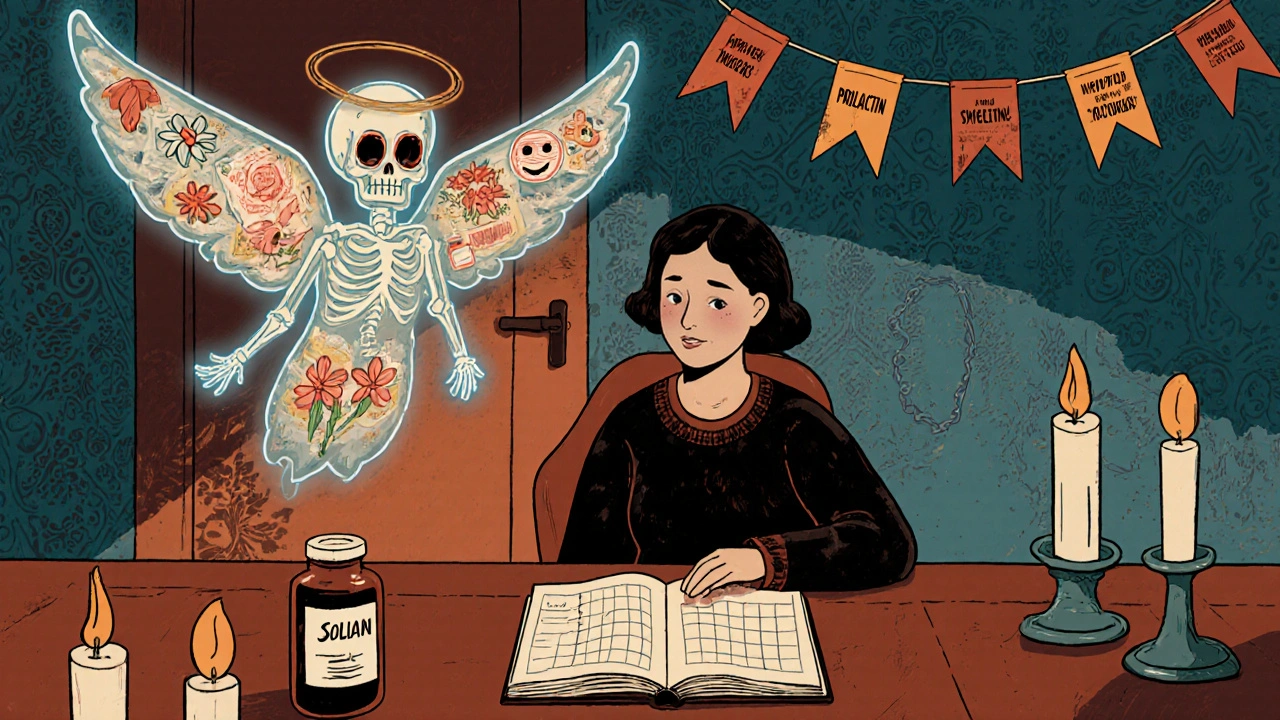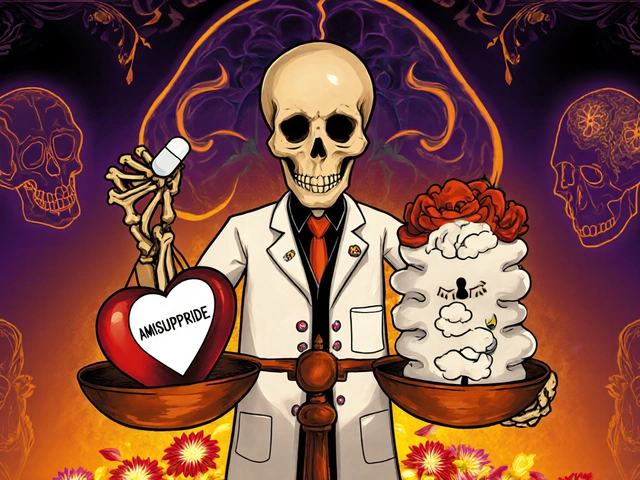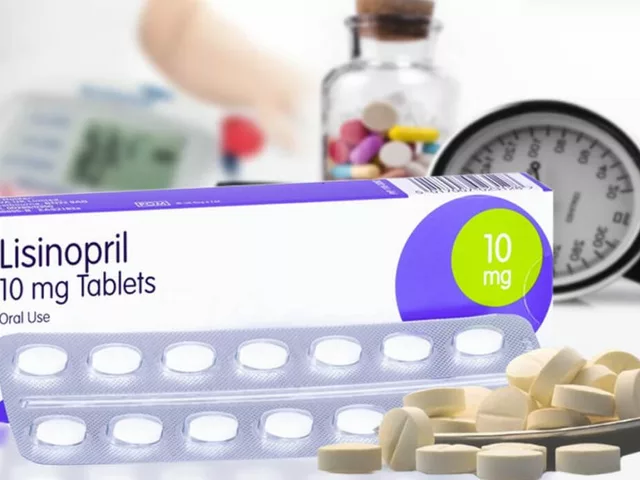Antipsychotic Side Effect Comparison Tool
Side Effect Priority Calculator
Select your top 1-2 side effect concerns to see which antipsychotics may be best suited for you.
Recommended Options
Important: This tool provides general information only. Discuss your individual situation with your healthcare provider.
Always follow your doctor's guidance regarding medication changes.
Solian (amisulpride) is an atypical antipsychotic used mainly for schizophrenia and depressive episodes in bipolar disorder. But it’s not the only option. Many people switch from Solian because of side effects, cost, or lack of results. So how does it stack up against other antipsychotics? Let’s break down the real differences - not just the textbook ones.
How Solian (Amisulpride) Works
Solian targets dopamine receptors in the brain, but differently than older antipsychotics. At low doses (50-300 mg/day), it mainly blocks D2 and D3 receptors in the limbic system, which helps with negative symptoms like emotional flatness, social withdrawal, and lack of motivation. At higher doses (400-1200 mg/day), it affects dopamine in the striatum, helping with hallucinations and delusions. This dual action makes it unique.
Unlike some other antipsychotics, Solian doesn’t strongly bind to serotonin, histamine, or acetylcholine receptors. That means fewer sedative effects, less weight gain, and lower risk of dry mouth or constipation - at least compared to clozapine or olanzapine.
Common Alternatives to Solian
Here are the most commonly prescribed alternatives to Solian, each with different strengths and trade-offs:
- Risperidone - Often used first-line for psychosis
- Olanzapine - Strong for positive symptoms, but high weight gain risk
- Quetiapine - Good for sleep and anxiety, but sedating
- Aripiprazole - Partial dopamine agonist, lower weight gain
- Ziprasidone - Low metabolic risk, but needs food for absorption
- Paliperidone - Long-acting injectable option
Side Effects: Solian vs the Rest
One reason people stop Solian is side effects. But how bad are they really? Here’s how it compares:
| Side Effect | Solian (Amisulpride) | Risperidone | Olanzapine | Aripiprazole | Quetiapine |
|---|---|---|---|---|---|
| Weight Gain | Low to moderate | Moderate | High | Low | High |
| Sedation | Low | Moderate | High | Low | High |
| Extrapyramidal Symptoms (EPS) | High (especially at high doses) | High | Moderate | Low | Low |
| Prolactin Elevation | Very High | High | Moderate | Low | Moderate |
| Metabolic Risk (diabetes, cholesterol) | Low | Moderate | High | Low | High |
| QT Prolongation Risk | Moderate | Low | Low | Low | Moderate |
Solian is notorious for raising prolactin levels - more than almost any other antipsychotic. That can lead to breast enlargement, milk production, missed periods, or low libido. If you’re on Solian and notice these symptoms, talk to your doctor. It’s not rare, and it’s manageable.
On the flip side, Solian causes less weight gain than olanzapine or quetiapine. For someone who’s already struggled with metabolic issues, that’s a big plus.
Effectiveness: Which One Works Best?
A 2023 meta-analysis in The Lancet Psychiatry looked at 32 trials involving over 8,000 people with schizophrenia. Solian performed similarly to risperidone and olanzapine in reducing positive symptoms like hallucinations. But it outperformed them in improving negative symptoms - the kind that make people withdraw from life.
That’s why Solian is often chosen for people who’ve tried other antipsychotics but still feel emotionally numb or disconnected. It’s not a magic bullet, but for some, it’s the only one that brings back a sense of being present.
Aripiprazole, on the other hand, is often better for people who want to avoid sedation or weight gain. But it can cause restlessness or even make psychosis worse in some cases because it partially activates dopamine instead of blocking it.

Who Should Avoid Solian?
Solian isn’t right for everyone. You should avoid it if:
- You have a history of prolactin-dependent tumors (like prolactinomas)
- You’ve had severe movement disorders from other antipsychotics
- You’re taking other drugs that prolong the QT interval (like certain antibiotics or antidepressants)
- You’re pregnant or breastfeeding - Solian passes into breast milk and can affect infants
Also, if you’re older or have heart problems, Solian’s moderate QT prolongation risk needs careful monitoring. Your doctor might order an ECG before and during treatment.
Cost and Accessibility
In Canada, Solian is available as a generic (amisulpride), which makes it cheaper than brand-name drugs like Abilify (aripiprazole) or Zyprexa (olanzapine). A 30-day supply of 50 mg tablets usually costs between $20-$40 CAD without insurance. With provincial drug plans, it’s often covered with a low co-pay.
That’s a big advantage over newer antipsychotics, which can cost over $100/month. For people on fixed incomes, that difference matters.
Real Stories: When Solian Works - and When It Doesn’t
One patient I spoke with, a 38-year-old teacher from Edmonton, tried risperidone for two years. It controlled her voices, but she gained 30 pounds and felt constantly tired. She switched to Solian. Her weight stabilized, and she had more energy. But her prolactin levels shot up - she started leaking milk and lost her period. After switching to aripiprazole, everything normalized.
Another person, a 52-year-old man with chronic schizophrenia, had tried everything. Olanzapine made him sleepy. Quetiapine didn’t touch his apathy. Solian was the first drug that helped him feel like himself again - no weight gain, no drowsiness. He’s been on it for six years.
There’s no one-size-fits-all. What works for one person can fail for another, even with the same diagnosis.

What to Ask Your Doctor
If you’re considering Solian or switching from it, here are five questions to ask:
- What symptoms are we trying to target - hallucinations, flat affect, or both?
- What’s my risk for prolactin-related side effects, and how will we monitor it?
- Have you checked for drug interactions with my other medications?
- What’s the plan if this doesn’t work after 6-8 weeks?
- Are there long-acting injectable alternatives if I struggle with daily pills?
Don’t be afraid to ask for a trial period. Antipsychotics can take 4-6 weeks to show full effect. Jumping ship too soon means you might miss out on something that could help.
Final Thoughts: Is Solian Right for You?
Solian isn’t the first drug doctors reach for - but it shouldn’t be the last either. It’s a powerful tool for people who need help with emotional numbness and social withdrawal without the weight gain of olanzapine or the restlessness of aripiprazole.
Its biggest downsides - high prolactin and movement issues - are manageable with monitoring. For many, the trade-off is worth it.
If you’ve tried other antipsychotics and felt like nothing helped, Solian might be worth a try. If you’re already on it and struggling with side effects, don’t just quit. Talk to your doctor. There’s almost always another option.
Is Solian better than risperidone for negative symptoms of schizophrenia?
Yes, studies show Solian is more effective than risperidone at improving negative symptoms like emotional flatness, lack of motivation, and social withdrawal. Risperidone is strong for hallucinations and delusions, but Solian’s unique action on limbic dopamine receptors gives it an edge in restoring emotional responsiveness.
Does Solian cause weight gain like olanzapine?
No, Solian causes significantly less weight gain than olanzapine. In clinical trials, people on olanzapine gained an average of 4-6 kg in 12 weeks, while those on Solian gained less than 1 kg. That’s why Solian is often preferred for patients with metabolic concerns like prediabetes or high cholesterol.
Can I switch from Solian to aripiprazole safely?
Yes, but it must be done slowly under medical supervision. Abruptly stopping Solian can cause rebound psychosis or withdrawal dyskinesia. Doctors usually taper Solian over 2-4 weeks while slowly introducing aripiprazole. Blood levels of both drugs are monitored to avoid interactions or side effect spikes.
Why does Solian raise prolactin so much?
Solian strongly blocks dopamine D2 receptors in the pituitary gland, where dopamine normally suppresses prolactin release. Without dopamine’s signal, prolactin surges. This effect is stronger with Solian than with most other antipsychotics because it binds very tightly to those specific receptors. It’s not a flaw - it’s how the drug works.
Is Solian used for depression?
Yes, low-dose Solian (50-300 mg/day) is approved in Europe and Canada for depressive episodes in bipolar disorder, especially when other antidepressants haven’t worked. It’s not a first-line treatment, but for treatment-resistant depression with apathy or lack of energy, it can be very effective.
How long does it take for Solian to start working?
For positive symptoms like hallucinations, you might see improvement in 1-2 weeks. But for negative symptoms - motivation, emotional expression - it can take 4-8 weeks. Don’t give up too soon. Many people only notice the full benefit after two months.
Next Steps
If you’re considering Solian or switching from another antipsychotic, start by tracking your symptoms and side effects. Use a simple journal: note your mood, energy, sleep, appetite, and any physical changes. Bring it to your next appointment.
Ask your doctor about blood tests for prolactin, fasting glucose, and cholesterol before starting and every 6 months after. If you’re on Solian and feel your symptoms aren’t improving after 8 weeks, don’t wait - revisit your treatment plan. There are other options, and you deserve to feel better.








